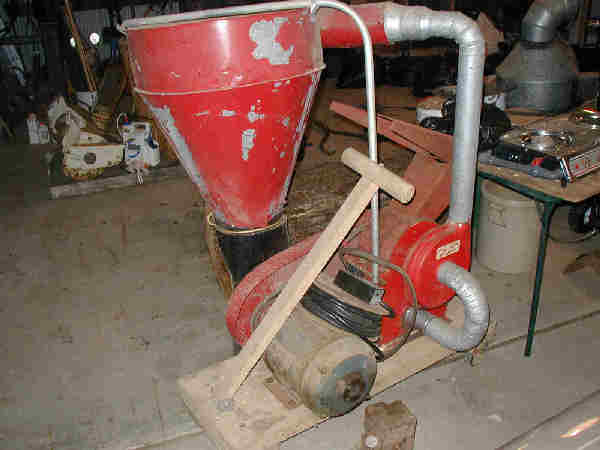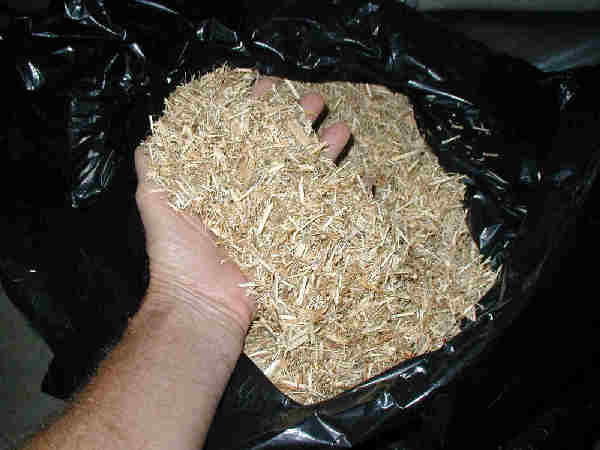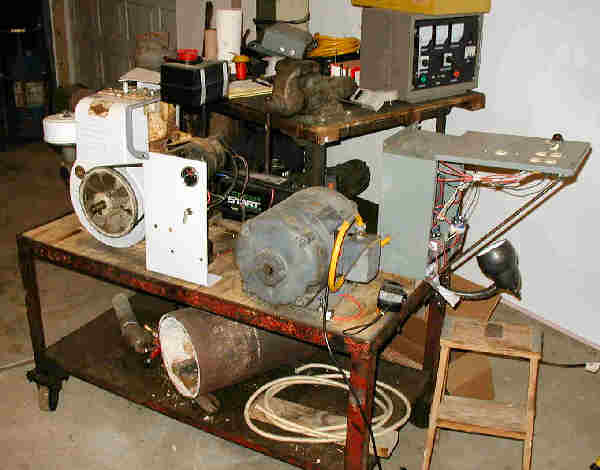I still haven't run an engine on woodgas yet, but I haven't died, either. This update is just to tell interested parties about a couple of things that are going on currently.


2. I have gotten an old 12 hp Briggs engine going and mounted it on a sturdy cart.
This one is rated 12 hp at 3300 rpm, so I hope it'll still have half that output when I slow it down to about
1800 to 2200 rpm for testing on woodgas. It came with a 4 1/8" diameter 2 sheave pulley.

3. A guy gave me 2 5hp 3 phase induction motors several years ago and one of them, after having help to get the
4 3/4" 2-sheave pulley loose, is now mounted on my "breadboard" cart and belted up to the Briggs.
This motor is a 9 wire Wye connected style, 208-240/480 volt ac, 60 Hz motor. I am planning for an output of 2 to
2.5 kw from this setup. I will load it with resistive loads that heat water during initial tests.
4. Since this motor/ induction generator is Wye connected, I intend to take 2 separate 120 vac circuits from one phase
and a single 208 volt output from that same phase. Excitation will come from capacitors across 2 of the phases.
After considerable reasearch, I see that I will need to connect the center of the Wye (the neutral)
to the frame of the motor. This system will be considered to be a "separately derived" system, according to the NEC.
So, there will be 5 wires exiting the motor: 3 phase leads, one neutral, and one equipment ground.
Doing the research to design exactly how make this motor work as a generator took some time on my part.
I wanted to meter the output well so I know exactly what I'm getting out of the system. So, I went looking for meters;
voltage, current and frequency. I wanted some nice panel meters, but I didn't want to spend a lot of money,
if I didn't have to.
After finding that the meters I needed cost about $50 apiece, I got out my old $27 "Killawatt" meter.
That's the kind of meter that you plug into the (120 volt) wall, then plug an appliance into to see how much energy it uses.
********************************************************************
Lo and behold!!! The Killawatt:
-AC voltage
-AC current
-Watts
-Reactive Power
-Power Factor
-Frequency
Well, at that price, how can I go wrong? I bought 2 of them. My SEIG (Separately Excited Induction Generator)
controller will have 2- 120 volt duplex receptacles and one 208/240 volt receptacle.
For now, all my load testing will be from the 120 volt circuits, so the "Killawatts" will do all I need,
on a continuous basis. If I need other readings, I can use a multimeter.
5.What's the holdup? The major problem, besides basic laziness, has been in balancing the capacitance on the
generator so that it both self-excites and stays excited when I load it down as much as possible.
There's some sort of governor problem with the engine that allows it to slow down too much when I go much above a 1 KW load.
I have spent a lot of time on this so far. If I run across a 4 to 6 KW Onan 1800 rpm generator set for a decent price, I
will snap it up so I can move on.
I see a lot of Youtube videos where the guys point the camera at the multimeter, but you usually can't really see what it says. I hope that IF I get to that point, I will be able to show clearly what is going on there.
For the electrical loads on the generator, I bought 10 of Surplus Center's 1250 watt @220 volt water heating elements for 99 cents apiece. I'll run them on 120 volts and add them in as needed (1/2 the voltage means 1/4 the wattage) to see how much power I can produce. First, of course on gasoline, then on woodgas.
Questions for myself:
I wonder what would happen if I used a farm tractor type oil bath air cleaner to clean up the woodgas.
The engine I am using has a foam air filter that must be soaked in oil before being installed. I wonder if a filter like that would help to trap tar?